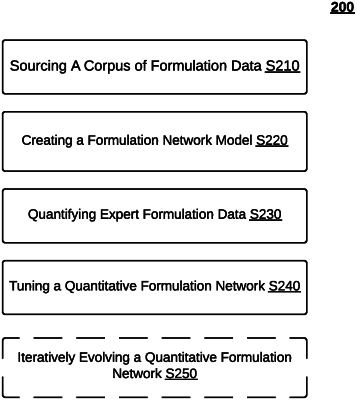| CPC G06F 30/18 (2020.01) [G06F 30/12 (2020.01); G06F 2111/00 (2020.01); G06F 2119/22 (2020.01); H04L 67/12 (2013.01)] | 17 Claims |

|
1. A computer-implemented method for an accelerated design of a virtual product formulation based on an expert data-enhanced quantitative formulation network, the computer-implemented method comprising:
sourcing, via a web-accessible interface, qualitative expert formulation data from one or more expert formulators interfacing with a remote formulation service;
at the remote formulation service that is implemented by a network of distributed computing systems:
creating a qualitative formulation network based on deriving from the qualitative expert formulation data a first set of network components including a plurality of distinct formulation variable nodes representing distinct formulation variables, a plurality of formulation edge connections representing distinct contributory relationships between the distinct formulation variable nodes, and a plurality of formulation parameter constraints that bound possible values for each of the distinct formulation variable nodes, wherein creating the qualitative formulation network includes:
mapping in an n-dimensional space the plurality of distinct formulation variable nodes in a relation to a target formulation objective, and
setting a distinct one of the plurality of formulation edge connections between distinct pairs of the plurality of distinct formulation variable nodes based on identifying a contributory relationship between two formulation variable nodes defining each of the distinct pairs;
extracting, from a formulation service-generated corpus of formulation data, qualitative network-expansion data based on a category associated with a target product associated with the qualitative formulation network, wherein the qualitative network-expansion data, when meshed into the qualitative formulation network, increases one or more of available formulation variables and available formulation edge connections within the qualitative formulation network;
creating, based on the qualitative network-expansion data, a second set of network components including one or more formulation variable nodes and one or more formulation edge connections;
integrating the second set of network components into the qualitative formulation network for expanding the qualitative formulation network;
transforming the qualitative formulation network integrated with the second set of network components to a quantitative formulation network by:
(i) converting a distinct qualitative value associated with each of the plurality of distinct formulation variable nodes of the qualitative formulation network to a distinct quantitative node value;
(ii) converting a distinct qualitative value associated with each of the plurality of formulation edge connections of the qualitative formulation network to a distinct quantitative edge value;
designing at least part of a virtual product formulation based on the quantitative formulation network, wherein designing the virtual product formulation includes:
extracting a subset of the distinct formulation variables associated with the plurality of distinct formulation variable nodes of the quantitative formulation network based on the distinct quantitative edge value associated with each of one or more of the formulation edge connections that connect to the subset of the distinct formulation variables, and
setting one or more formulation variables of the virtual product formulation using the subset of the distinct formulation variables associated with the plurality of distinct formulation variable nodes of the quantitative formulation network; and
generating a target formulation proposal that likely satisfies the target formulation objective based on executing the virtual product formulation as designed.
|